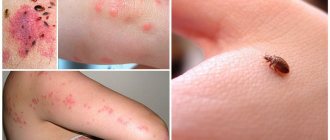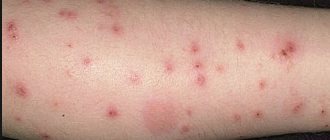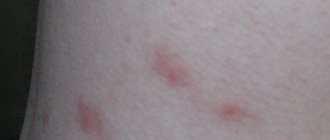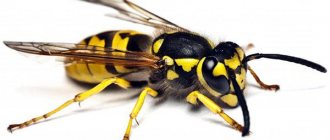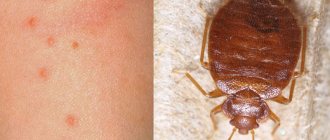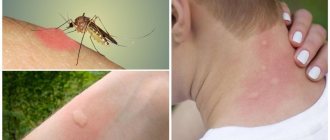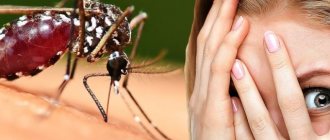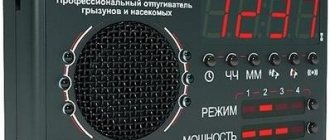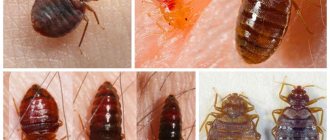How to distinguish a flea from a bedbug?
Externally, these small parasites differ from each other. You can identify a bug by its characteristic feature - an oval, flat body of a brown hue. A sexually mature individual reaches a length of 5-8 mm.
The bug is easy to notice with the naked eye, given that the insect moves slowly. They are usually located under mattresses, under furniture upholstery, in old pillows, and in crevices of wooden bed frames.
Flea bite
It is more difficult to detect fleas in an apartment. These are small insects no more than 2-3 mm long. Their body is flattened laterally and has a dark brown color. Parasites jump easily and can move quickly. They live in any secluded corners - behind furniture, under baseboards, behind poorly glued wallpaper, etc.
How do bedbugs bite?
Insects are nocturnal hunters living in groups, attacking their prey during the period of deepest sleep - from 2 to 6 am. Each individual has the ability to recognize the current and pulsation of the victim’s blood, and in search of food tries to get to the most accessible capillary.
The food that a bedbug needs to satiate is twice its own weight; Neither bright light nor noise can scare off an insect that senses blood.
Pin
At one time, the parasite sucks up to 1 ml of blood, then moves along the vessel and begins to feed again, making a new puncture 1.5 -2 centimeters higher.
During the night, the bloodsucker can make up to 5-6 punctures; the entire feeding period takes up to half an hour in one night. Since insects feed in groups, after the “hunt” large red merging spots remain.
The bedbug larva is externally a miniature copy of an adult insect, but has a translucent body through which the blood-filled stomach is visible. A few minutes are enough to saturate the larvae. The bloodsucker does not go hunting every day. Full feeding allows him not to experience hunger for up to 1.5 weeks.
Bedbug bites are not dangerous to humans - these insects practically do not carry infectious agents, but they cause extremely unpleasant marks on the skin, reminiscent of a painful rash, painful itching, the appearance of a specific body odor, constant irritation and the manifestation of allergy symptoms.
On the skin of the affected person, a characteristic chain of marks remains along the superficial vessels, formed from red swellings with drops of blood at the tops. The distance between them is up to a centimeter. A feeding pest can leave such traces during one night feeding.
A characteristic feature is the multiplicity of traces (up to 50 or more).
No parasitic insect can leave them in such numbers. To provide timely assistance to a bitten person, you need to be able to distinguish bedbug bites from lesions caused by other bloodsuckers.
How are bed bug bites different from flea bites?
Bedbug and flea bites are similar in appearance in many ways, but there are also significant differences. Common signs are severe itching, redness of the skin, swelling and increased temperature in the affected area. Let's look at how to determine the type of parasite based on its bite mark:
What do the bites look like?
The following signs are characteristic of flea bites:
- clear visualization of the bite site;
- redness of surrounding tissues;
- severe itching;
- sharp pain at the time of the bite.
Flea bite marks are located randomly on a person. Most often the legs, abdomen, and lumbar region are affected.
Bed bugs behave differently. These parasites cannot receive the required portion of blood instantly, so they are forced to stick to the body. To do this unnoticed, they inject a special substance into the wound that serves as an anesthetic. The person does not feel the moment of the bite and continues to sleep. After 2-3 hours, he develops a severe allergic reaction, manifested by itching, burning and swelling.
Traces of bed bug bites are not isolated. They line up at a distance of about 5 cm from each other. The softest areas most often affected are the abdomen, neck, buttocks, and inner thigh. Dried blood may be found at the site of the bite.
A bug or flea bite can be distinguished based on the time of detection. Signs of bedbug infestation are usually detected in the morning after waking up, since it is easier for insects to feed on the blood of a sleeping person. Fleas attack at any time of the day.
Differences from other skin manifestations
In summer, in warm weather, other bloodsuckers can attack humans. There is a simple way to distinguish a flea or bedbug bite from other insects. It is enough to evaluate the appearance of the inflamed area. If a mosquito bites, a small blister with fuzzy edges develops. If a red dot is clearly visible in the center of the wound, this is a midge bite.
Bedbug bite
Inflammation may be a consequence of blockage of the sebaceous ducts. In this case, pay attention to the place of its localization. Parts of the body with rough skin are not attractive to insects. In addition, they are not able to bite through thick clothing.
How long does it take?
A flea or bedbug bite causes discomfort, but severe itching and swelling subside within 2-3 days. Then only a red mark remains on the skin. It will take 5-7 days for it to disappear.
You can quickly deal with bite marks from blood-sucking parasites if you don’t scratch them. Microbes can get inside through the affected area of the epidermis. Then an infection sets in and suppuration occurs. If the itching is unbearable, you can use a specialized ointment after insect bites.
The body's reaction to bites
It all depends on the individual sensitivity of the person. Children and people with thin, delicate skin can develop a severe allergic reaction from a bedbug or flea bite. The following symptoms are observed:
- redness of a large area of skin;
- merging of several small bite marks into one large one;
- hyperemia (arterial blood flow to the affected area);
- swelling of the skin;
- unbearable itching.
In the most severe cases, general health deteriorates - weakness develops, body temperature rises. For severe allergic reactions, it is best to consult a doctor or take an antihistamine.
Symptoms of a flea bite
The anatomical structure makes the insect almost invisible to the human eye and elusive. The body, flattened on the sides, is covered with a chitinous shell and spines (brushes), thanks to which the flea quickly moves through the fur. Strong pushing hind legs enable the horse to cover distances quickly.
Unlike its blood-sucking brother, the flea leaves other traces after a meal:
- the site of the bite is clearly visible, surrounded by a red, swollen spot;
- the prints are arranged in a chaotic order, often concentrated on the legs and back;
- the flea does not inject an anesthetic at the time of the bite, so a sharp sensation of pain accompanies the attack of the parasite;
- acute allergic reaction, possible inflammation and suppuration.
Important!
Fleas are carriers of diseases such as typhoid, encephalitis, plague, etc., therefore, if signs of an attack are detected, you must seek the advice of a specialist.
The appearance of parasites in the house requires a prompt and professional solution to the problem. Getting rid of infested furniture does not guarantee complete destruction of insects, since the habitat is often not limited to one specific place. The ability to go without food for a long time, suspended development due to low temperatures, complicate the process of destroying parasites significantly. High temperatures reduce the lifespan of a flea by about 40%, while low temperatures slow down development, thereby prolonging the existence of the parasite. The bug easily tolerates temperatures up to 50 degrees.
Whose bite is more dangerous?
The flea bites are very itchy immediately after the parasite attack, but the discomfort goes away faster. When bed bugs bite, they secrete saliva and an anesthetic into the wound. It provokes a severe allergic reaction, accompanied by swelling and hyperemia.
Complications - ulcers, eczema - can develop from any insect bites. The body's reaction does not depend on the type of parasite that drank the blood, but on subsequent care of the wound. If you do not touch the damaged skin with dirty hands and do not comb it, then big problems will not arise.
How fleas bite
Fleas are blood-sucking parasitic insects classified as Siphonaptera. They are often found on the fur of domestic and other animals. With their powerful jaws, the parasites bite into the skin and suck blood.
Flea bites are chaotically located red dots, sometimes in the form of a long path. Subsequently, they swell, increase in size and itch severely, causing pain. Then blisters appear, but without a red discharge in the center.
Fleas bite mainly from below: on the ankles, feet, heels, shins, ankles or armpits. In those parts of the body where the skin is thinner. Bites heal on their own in 4-5 days.
There are different types of fleas:
- felines;
- canine;
- earthen;
- bedding;
- linen.
The last 3 varieties are settled in houses and apartments. They are often confused with bedbugs. They are active in winter and summer, similar to bedbugs. Moreover, they are localized in sleeping areas.
Possible consequences
In addition to an allergic reaction, fleas can cause pulicosis in humans. This is a skin disease accompanied by:
- the formation of purulent wounds;
- increase in body temperature to 37-380C;
- enlarged lymph nodes;
- the appearance of ulcers in the throat and mucous membranes of the mouth;
- headaches;
- insomnia.
Increased body temperature
The danger of bedbug and flea bites lies in the risk of contracting dangerous diseases. Blood-sucking parasites carry pathogens:
- typhoid fever;
- smallpox;
- tularemia;
- brucellosis;
- pseudotuberculosis.
All of these diseases require seeing a doctor and prescribing medication.
How to determine if there are fleas at home. What do flea bites look like (photo)
To determine if there are fleas in the house. General characteristics of fleas:
- Color: reddish brown
- Size: 1 mm - 5 mm in length depending on the type
- Shape: oval
- Moves: by jumping
- Food: blood
- Do they carry diseases: yes
- Insects with complete metamorphosis
Fleas are very small in size, feed on blood, have no wings, and move by jumping. Insects usually live on 1-2 floors of apartment buildings or basements.
People can enter the premises with animals, on clothes from a walk, from neighbors, or from the basement.
How to treat bedbug bites
Bedbug bites require immediate treatment to relieve discomfort and protect the wound from penetration of various pathogens. Both folk remedies and pharmaceutical preparations can help with this.
How to proceed:
If a bug has bitten a child, then you need to take into account his age before giving him an allergy pill. If a bug bites a pregnant woman, then you need to take into account the fact that in this situation antihistamines are contraindicated for her
It is possible that you will have to make do with folk remedies, such as aloe juice, plantain juice, decoctions of St. John's wort and chamomile. Particular attention should be paid to children and expectant mothers, so the best option is to see a dermatologist who can make the right decision and prescribe the right medications. Stages of wound treatment:
Stages of wound treatment:
- After a bite, the wound should be immediately treated with soap or soda solution, propolis or alcohol. An alternative is to treat the wound with alcohol-containing liquids, such as cologne, perfume, vodka or moonshine.
- A piece of gauze soaked in cold water should be applied to the bite site.
- In case of severe discomfort, take an antihistamine.
- After this, the bite site is treated with ointment or gel, which is designed to combat insect bites.
- In case of serious consequences, when there is a deterioration in health, it is better to seek help from a dermatologist.
Medications
When bedbugs attack their prey, after their bites several wounds remain on the human body, the number of which can reach 10 pieces, or even more. Naturally, the discomfort in this case is very noticeable and immediate intervention is required. Ointments and gels will help relieve a person from negative consequences. Plus, the use of sorbents and antihistamines will help get rid of serious complications such as allergies and poisoning of the body with toxic substances.
Effective means include:
- The drug "Fenistil-gel" will quickly help relieve burning and itching.
- “Rescuer” balm will help quickly heal the wound and relieve swelling.
- Menovazin can reduce the risk of allergic reactions due to multiple bites.
- Star balm will also help cope with the negative consequences of bedbug bites.
Tablets and sorbents
Bedbug bites often do not go away without a trace, so doctors always prescribe antihistamines and sorbents that help remove toxins from the human body that can lead to allergic reactions.
Antihistamines:
- Suprastin.
- Fexofenadine.
- Claritin.
- Telfast.
- Zodak.
- Cetirizine.
- Suprastinex.
- Cetrin.
- Diazolin.
- Erius.
- Loratadine.
- Ebastine.
The following are accepted as sorbents:
- Activated carbon.
- Polysorb.
- Enterosgel.
- Polyphenol.
- White coal.
- Smecta.
Some sorbents have a wider spectrum of action, removing toxins from the body, as well as having a beneficial effect on the mucous membrane of the intestines and stomach.
How to get rid of bedbugs - destruction, control, signs
Watch this video on YouTube
Folk remedies
When you don’t have pharmaceuticals at hand, then you can get by with folk remedies that involve the use of natural ingredients. To relieve irritation and itching, as well as disinfect the wound, you can use:
- Plantain, treating the wound with its juice.
- Propolis tincture.
- A decoction of St. John's wort or chamomile.
- Apple cider vinegar.
- An aqueous solution of soda.
- Soap and water solution.
- Aloe juice or pulp.
First aid for bedbug bites
Knowing what to do if you are bitten by bedbugs, you can significantly reduce the duration of the itching or completely remove it and prevent secondary infection of the skin.
First aid supplies
There are various methods to treat bedbug bites. Here are several options for treating bedbug bites to relieve itching:
- Soap or soda solution to wash the affected areas.
- Fresh parsley or potato juice.
- An excellent ointment for bedbug bites is Afloderm or asterisk.
- Alcohol tincture of propolis.
- Menovazin.
- Ammonia.
- Fenistil gel. Has a combined effect, reduces the level of allergic reaction.
- Rescue cream. It can not only relieve itching, but also protect against allergies and secondary infection.
Before applying a new product to bedbug bites, it is better to try it on the inside of the elbow so as not to cause an additional allergic reaction.
Emergency doctors should know how to treat bedbug bites in the event of an allergic reaction. If severe swelling, shortness of breath or loss of consciousness occurs, or a sharp decrease in pressure, it is necessary to provide the victim with rest and urgently call an ambulance. If a reaction of moderate severity occurs, you can take antihistamines - diphenhydramine, tavegil, diazolin or others available.
How to get rid of furniture bugs and bed mites?
No one is safe from the appearance of blood-sucking insects in the house. The most famous and common parasites are furniture mites and bedbugs. They feed on the blood of warm-blooded creatures, going out to hunt in the dark. And if a person feels bedbug bites, then the ticks bite unnoticed.
However, after these bites, an allergic reaction accompanied by itching may develop. In order for the fight against parasites to be effective, it is very important to distinguish whether harmful small bed mites or house bugs have settled in your home.
The main differences between ticks and bedbugs
From a distance, bedbugs and ticks are very similar. But if you look closely, you can see that the representative of the Arachnida class has eight legs, while bedbugs have six.
Bed mites have impressive dimensions and can be up to 8 mm in size. Their cousins, dust mites, are quite difficult to detect due to their small size. Furniture bugs are nocturnal bloodsuckers, while linen mites feed on dead skin particles.
Our readers recommend! To get rid of bedbugs and other insects, our readers recommend the Pest-Reject repeller. The operation of the device is based on the technology of electromagnetic pulses and ultrasonic waves! Absolutely safe, environmentally friendly product for humans and pets.
Bed bugs live in secluded dark places in the apartment. They can be found in furniture, under baseboards and wallpaper, in old things. House mites live in feather blankets, pillows, and blankets.
What do furniture bugs look like?
Popularly, these parasites are called bed bugs because they most often settle in beds and sofas to be closer to the victim.
The insect, measuring from 3 to 8 mm, can be dirty yellow to dark brown in color. It has a flattened body and a special proboscis on its head. This proboscis is divided into narrow and wide channels. From the narrow channel, saliva containing an anesthetic substance is injected into the wound, and blood is absorbed through the wide channel.
Even at the stage of larval development, glands secreting a special secretion develop on the back of the parasite. They produce an odor that is characteristic of bedbugs. The oblong curved eggs of blood-sucking insects are whitish in color. Depending on environmental conditions, the larvae may hatch within a few days or weeks.
The larvae differ from adult individuals in their lighter color and smaller size. They do not yet have a special anesthetic substance in their saliva, so the bites of young individuals are more sensitive.
Signs of furniture bugs
Parasites can enter an apartment or house along with old furniture, pets or clothes after visiting guests. If a dysfunctional family lives in a neighboring apartment, then insects can migrate away from them through cracks or ventilation.
To quickly get rid of bedbugs and other insects, there are only three effective options:
- Calling a pest control service (expensive);
- Purchase of an inexpensive electronic repeller (1390 rubles);
- Chemicals (doubtful effect).
We recommend: What causes bedbugs in the house?
The fact that furniture bugs have appeared in the house can be determined by the following signs:
- Bites on the body after a night's sleep. Crawling along the body, the bug constantly bites, so after it the bites are located in the form of “paths”.
- Discarded chitinous covers.
- Dark experiments.
- A sharp, unpleasant odor reminiscent of coriander.
As soon as suspicions creep in that bedbugs have appeared in your house, you need to immediately inspect the possible places of their settlement:
- joints of upholstered and wooden furniture;
- curtains, mattresses, pillows, beds, clothing seams;
- behind skirting boards, torn wallpaper, paintings, books,
- under carpets and floor coverings,
- behind radiators, door jambs, under window sills.
Blood-sucking insects crawl out of their hiding places in search of prey only at night.
How dangerous are bedbug bites?
Bedbug bites resemble allergies or mosquito bites, so you may not immediately understand that parasites have appeared in your home. During the night, one individual makes up to seven punctures, which a sleeping person may not even feel. The marks left at the site of bedbug bites may not itch. You can find out that you were bitten by a bug by the nature of the skin injury. Red spots located one after another with a dark dot inside are bites of nocturnal blood-sucking insects.
Gallery: furniture bug (25 photos)
Furniture bugs - how to get rid of them?
Bedbugs quickly get used to chemicals, so finding a universal remedy for their destruction is almost impossible. Therefore, to get rid of bed bugs in an apartment yourself, you can use several simple methods:
- Temperature treatment. Parasites are killed by frost below -20 degrees and high temperatures above +40 degrees. Therefore, it is useful to take bedding and small furniture outside for 2–4 hours in frosty and hot weather. You can also use a household steam generator.
- Quartzization. Before treating the room and things with an ultraviolet lamp, you must open the cabinet doors, open the sofas, and place bedding under the lamp.
These methods will help reduce the number of insects in the house. However, with their help it will not be possible to completely get rid of parasites.
Modern chemicals
In stores you can buy modern means to combat bedbugs, before using which you need to prepare the room:
- take out or hide food in the refrigerator;
- pack dishes;
- After making sure that there are no bedbugs in clothes and children's toys, pack them in impenetrable bags;
- cover the aquariums tightly;
- remove pets, birds, people from the apartment.
The person who will treat the premises with chemicals must wear personal protective equipment.
The most effective and popular means for exterminating furniture bedbugs include:
- Delta Zone. Microencapsulated drug, the action of which leads to paralysis and death of parasites. Its active substance is the insecticide deltamethrin. The main advantage of this remedy is that its effect lasts for several months.
- Pyrethrum. The drug contains a natural component that is obtained from chamomile flowers. Therefore, the insecticide is completely harmless to people and pets. Available in aerosol or powder form.
- Combat Superspray. The drug, which contains cyphenothrin and imiprotrin, paralyzes bedbugs and leads to their death. It comes in the form of an aerosol and has a citrus scent.
- Executioner. The product contains the active substance fenthion. Its action paralyzes the nervous system of the parasite and leads to its death. The drug is available in liquid form. Before use, it must be diluted according to the instructions.
We recommend: What types of bedbugs are there: house parasites, bedbugs
If you can’t get rid of furniture bugs on your own, you can call an insect removal service. Specialists will carry out disinfestation of the premises efficiently and quickly.
Appearance of a bed mite
The small arachnid insect is almost impossible to see with the naked eye. The largest size of a female tick is 0.2 mm. Under a microscope, you can see six small legs that end with suction cups. Thanks to them, parasites adhere tightly to the surface and are almost impossible to remove from carpet, upholstered furniture, clothes, and linen.
The body of ticks is covered with a chitinous shell, which is not wetted by water. That is why it is not possible to get rid of them using liquid products.
Linen mites vary in their gastronomic preferences. Some feed on cotton or linen fabrics, while others prefer wool pile or coconut fiber. Some parasites can even eat food scraps or paper.
Signs of a room being infested with ticks
The presence of bed parasites in the house can be determined by a person’s well-being. The most common symptoms include:
- runny nose;
- inflammation of the mucous membranes of the eyes with redness and tearing;
- the appearance of wheezing and breathing problems;
- rashes on the skin without bite marks;
- sneezing without signs of a cold;
- temperature rise is possible.
Only a specialist can diagnose the nature of the rash, so if it appears, it is recommended to consult a doctor. If possible, laboratory tests should be carried out to accurately show whether bed mites live in your home.
What is the danger of bed ticks?
Small parasites settle in warm and humid places closer to the source of food. The best habitat for them are pillows, mattresses, blankets and sheets. Millions of house ticks can live in one pillow, each defecating about 20 times a day. Fecal pellets contain proteins that often cause an allergic reaction in people who come into contact with them.
We recommend: Are water bugs and giant ones also dangerous for humans?
People susceptible to allergic diseases and young children most often suffer from parasites. In adults, in addition to rashes on the body, the eyes may become watery, the throat may become red, nasal congestion may occur, the temperature may rise and even develop eczema. Children who come into contact with linen mites without visible preconditions may develop bronchial asthma, which will be almost impossible to cure.
Means and methods for exterminating bed mites
You can get rid of ticks in your home by creating unfavorable living conditions for them:
- in summer, dry bedding in direct sunlight;
- in winter, take pillows and mattresses out into the cold for several hours;
- wash clothes in hot water;
- treat feather and down blankets and pillows with chemical deep cleaning in specialized centers;
- steam the upholstery of upholstered furniture.
You can destroy small parasites yourself using a product prepared from ammonia and soap (2:1). This mixture is used to treat surfaces and things that may be infected with ticks.
Chemicals
If the health of household members has sharply deteriorated, it means that the parasite population is of alarming proportions. In this case, it is necessary to use caracid antiallergenic drugs:
- Allergoff spray or component that is added to the washing solution.
- Easy Air Liquid.
- Milbol spray, which contains neem plant oils. They treat furniture and beds with it.
- Insectoacaricide "Tsifoks". Before use, according to the instructions, it must be diluted in water. Re-processing required.
- The drug is in the form of powder "Acaritox". The aqueous solution prepared according to the instructions after treatment remains effective for two weeks.
- Highly effective product "Sipaz Super". Its use gives 100% positive results.
It is difficult to completely get rid of domestic bed mites. Regular control of them will prevent the population from developing and will reduce the risk of allergic diseases.
Parasites are dangerous to humans both because of their bites and because they can cause allergic reactions. Therefore, if ticks or bedbugs are found in the house, you must immediately begin to destroy them using proven and effective means.
Attention, TODAY only!
How to prevent bed bugs?
It is almost impossible to completely insure yourself against bedbug bites due to the lack of developed traditional remedies. However, everyone can take some steps to prevent these insects from appearing in an area that has not yet been infested.
First of all, you need to position the bed so that it does not come into contact with walls or other pieces of furniture. Now you need to shake the laundry and check if there are any insects or their larvae on it
Special precaution - steam treatment of the mattress with an iron or steamer
Now it’s the pillow’s turn: you need to remove the pillowcase and carefully inspect all the seams. If the pillow has been in use for a long time, it is better to purchase a new one or give the old one for processing. Then you can make the bed again, but so that the linen does not come into contact with the floor surface. In addition, if necessary, vessels with water are placed under each leg of the bed. After the procedure, the likelihood that insects will disturb the peace of the room’s inhabitants becomes extremely small. However, do not forget that bed bugs can move to the walls and then return to the bed.
To summarize, we can say that bedbugs are a nuisance that can and should be dealt with, but do not panic if your body is covered with their bites: they usually do not cause serious consequences. If infection or severe allergies occur, you should immediately consult a dermatologist.
Useful article, thank you! 1I don’t like it, delete it!
